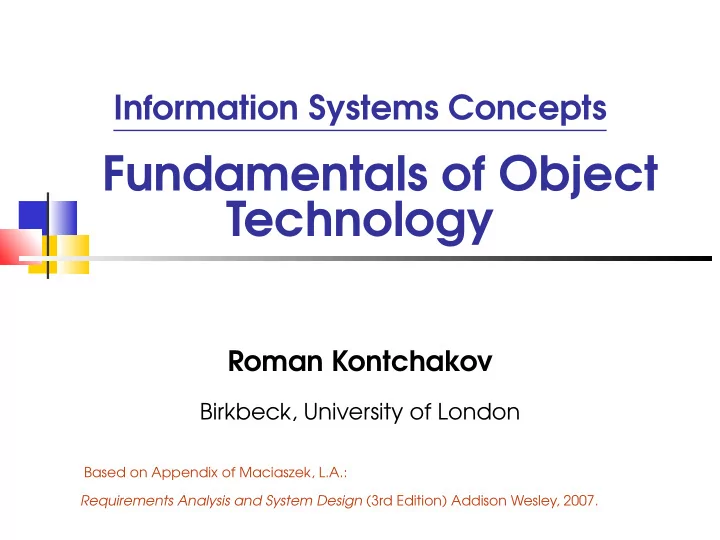

Information Systems Concepts Fundamentals of Object Technology Roman Kontchakov Birkbeck, University of London Based on Appendix of Maciaszek, L.A.: Requirements Analysis and System Design (3rd Edition) Addison Wesley, 2007.
Outline Object Class Association Aggregation and Composition Generalization Inheritance Polymorphism ISC 2018-R 1
Object: State, Behaviour & Identity NB: equal � = identical Booch, G.: Object Oriented Analysis and Design with Applications (2nd Edition) Addison-Wesley, 1994 ISC 2018-R 2
Class Class represents a set of objects that share a common structure and a common behaviour Objects are instances of classes Booch, G.: Object Oriented Analysis and Design with Applications (2nd Edition) Addison-Wesley, 1994 ISC 2018-R 3
Objects: UML Notation c1: Module object-name : class-name module code = COIY016H4 attribute-name = value module name = Information Systems Concepts NB: ‘ :Module ’ is an anonymous instance of class Module NB: ‘ c1 ’ is an object without a specified class NB: there is no compartment for operations! ISC 2018-R 4
Classes: UML Notation Purchase class name id: Integer attribute names and types date: Date value: Currency operation signatures reorder(product: Product) ISC 2018-R 5
Abstraction Abstraction focuses upon the essential characteristics of some object, relative to the perspective of the viewer Booch, G.: Object Oriented Analysis and Design with Applications (2nd Edition) Addison-Wesley, 1994 ISC 2018-R 6
Encapsulation Encapsulation hides the details of the implementation of an object Booch, G.: Object Oriented Analysis and Design with Applications (2nd Edition) Addison-Wesley, 1994 ISC 2018-R 7
Operations (in Communication Diagrams) :Order → 1.1.1: checkLevels() ↓ 1: shipOrder(order: Order) :Shipment :Stock → 1.1: getProducts(order: Order) ↓ 1.1.2: reorder(product: Product) :Purchase ISC 2018-R 8
Operations (in Class Diagrams) Stock Order getProducts(order: Order) checkLevels() Shipment Purchase shipOrder(order: Order) reorder(product: Product) Product ISC 2018-R 9
Associations Shipment Order id: String id: Integer ◮ Order Shipment date: Date date: Date 1 1..* carrier: String value: Currency shipOrder(order: Order) multiplicity: 0..1 0..* 1..* n ���� ���� ���� ���� none or one any number at least one exactly n ISC 2018-R 10
Association Classes ModuleOffering Student ◭ Module Taken 0..* 0..* Assessment marks: List totalMark: Number grade: String ISC 2018-R 11
Composition & Aggregation Aggregation : by reference (transitive and asymmetric) Crate Bottle ◮ contains 0..1 0..* Composition : by value (transitive, asymmetric and existence-dependant ) Book Chapter Section ◮ contains ◮ contains 1 1..* 1 1..* ISC 2018-R 12
Generalization A subclass inherits the structure and behavior of its superclass Booch, G.: Object Oriented Analysis and Design with Applications (2nd Edition) Addison-Wesley, 1994 ISC 2018-R 13
Inheritance in Java Employee Person startDate: Date name: String leaveEntitlement: Integer dob: Date leaveTaken: Integer age(): Integer remainingLeave(): Integer public class Person public class Employee extends Person { { private String name; private Date startDate; private Date dob; private int leaveEntitlement; private int leaveTaken; public int age() { return getYear() public int remainingLeave() { - getYear(dob); return leaveEntitlement - leaveTaken; } } } } ISC 2018-R 14
Polymorphism in Java Employee Manager startDate: Date leaveEntitlement: Integer leaveSupplement: Integer leaveTaken: Integer remainingLeave(): Integer remainingLeave(): Integer public class Manager extends Employee { private int leaveSupplement; public int remainingLeave() { int l = super.remainingLeave(); return l + (leaveSupplement); } } ISC 2018-R 15
Take Home Messages Each object has a state, behaviour and identity Class defines attributes and operations There are three kinds of relationships between classes: association, aggregation/composition and generalization Generalization provides basis for inheritance and polymorphism ISC 2018-R 16
Recommend
More recommend